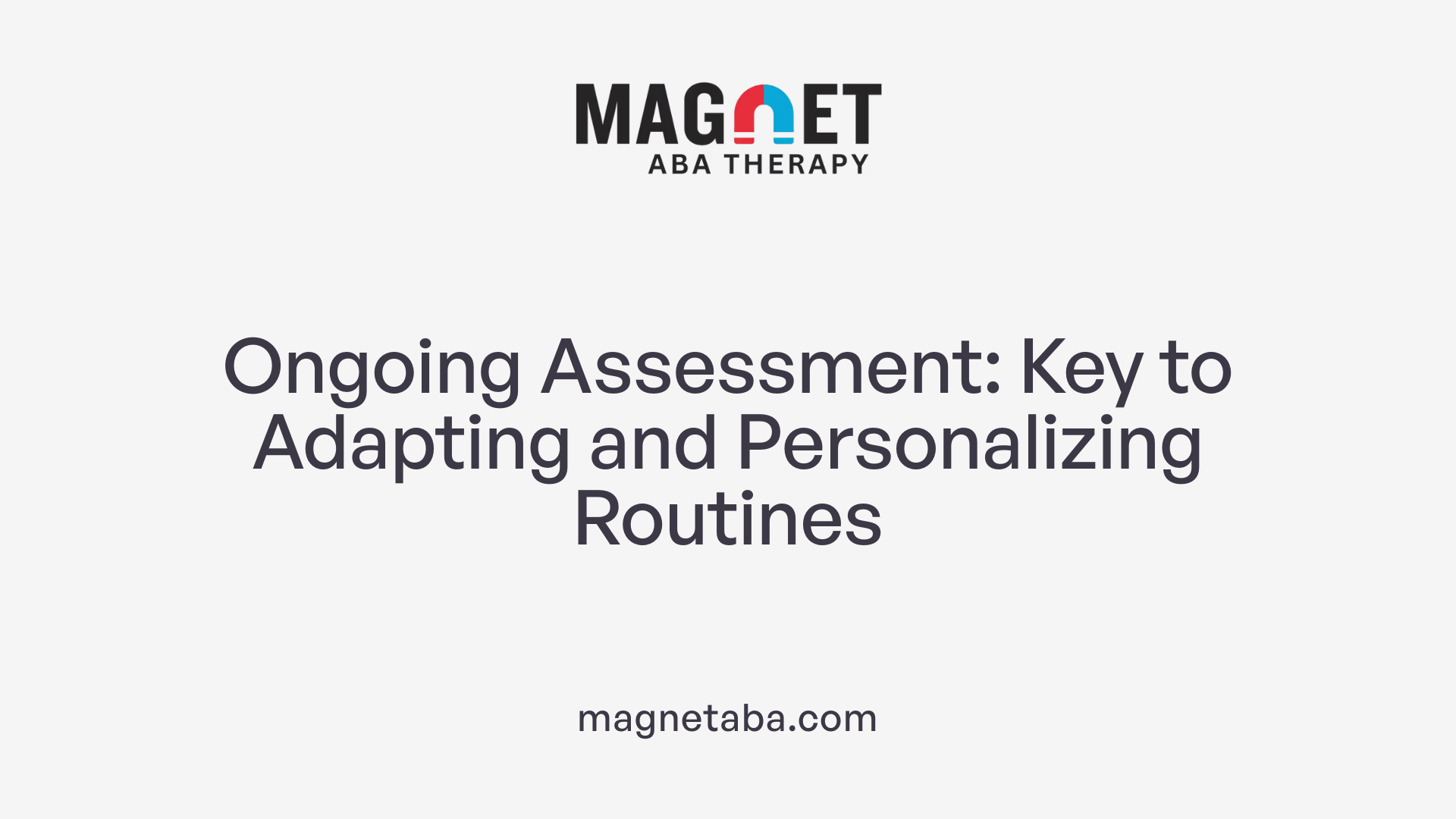Enhancing Daily Life Skills with ABA Techniques
Teaching functional routines within educational and home settings is fundamental for fostering independence, social skills, and emotional regulation in children with autism. Applying evidence-based ABA strategies enables educators, therapists, and caregivers to facilitate meaningful skill acquisition, ensuring these routines become natural parts of a child's daily life. This comprehensive overview explores effective methods for teaching routines using ABA principles, underlining the importance of structured, personalized, and consistent practices.
Understanding the Role of Functional Routines in Autism Support
What are functional routines and why are they important in teaching children with autism?
Functional routines are predictable sequences of activities that help children develop essential life skills and provide structure throughout their day. They include typical daily activities such as eating, bathing, playing, and riding in a car, which form the foundation for independence.
Why are these routines vital? For children with autism, consistency and predictability reduce anxiety and help them understand what to expect next. This structured environment makes it easier for children to learn new skills, generalize these skills across different settings, and feel more secure.
Teaching these routines using evidence-based methods like applied behavior analysis (ABA) involves strategies like task analysis, visual supports, and reinforcement. By focusing on natural settings, such as mealtime or outdoor play, educators and caregivers can embed learning opportunities that promote social, communication, and daily living skills.
How can routines support social and language development?
Routines create ideal opportunities for children to develop their social and speech skills. During everyday activities, children practice requesting, greeting, and turn-taking, which are fundamental social behaviors.
For example, during mealtime, children might be encouraged to express the need for food by pointing, using pictures, or verbalizing the word "pizza". These interactions foster communication skills. Similarly, during cleaning or dressing routines, children can imitate actions or learn new vocabulary.
Consistent routines also promote social engagement by encouraging children to participate in shared activities, respond to cues, and wait their turn, helping them build positive interactions with peers and adults. Using strategies like visual supports, reinforcement, and modeling during routines makes learning engaging and meaningful.
Examples of Daily Routines
| Routine Activity | Description | Teaching Strategies |
|---|---|---|
| Eating | Children learn to request food, use utensils, and develop table manners | Visual cues, prompting, positive reinforcement |
| Hygiene | Bathing, brushing teeth, dressing | Visual schedules, modeling, social stories |
| Play and Leisure | Engaging in outdoor play, games, hobbies | Video modeling, naturalistic teaching, social skills modeling |
| Transportation | Riding in a car or bus | Practice with visual supports, gradual desensitization |
| Rest and Sleep | Morning and bedtime routines | Consistent schedules, visual timers |
Embedding these routines into everyday life promotes independence, reduces behavioral issues, and encourages skill versatility across environments. Consistency supported by visual aids such as checklists, token boards, and schedules helps children track their progress and feel more confident.
Incorporating routine teaching into therapy and daily activities creates a seamless learning experience, making development an integrated process. This approach not only benefits children with autism but also supports families and educators in creating nurturing, structured environments that foster growth and success.
Using ABA Principles to Teach Routines Effectively
How can ABA strategies be used to teach routines and develop daily living skills?
ABA strategies are highly effective in teaching routines and fostering independence in children. They utilize task analysis to break down complex activities, such as brushing teeth or dressing, into smaller, manageable steps. Visual supports like schedules, picture cards, and checklists help children understand and follow these steps. Prompting techniques, including modeling and physical prompts, guide children through each part of the routine. As children become more independent, prompt fading reduces assistance gradually. Positive reinforcement, such as praise or tokens, motivates repeated practice. Involving families and caregivers ensures skills are practiced across settings, promoting generalization. Continuous data collection allows for tailored adjustments, maximizing each child's progress in everyday skills.
What are some effective ABA techniques for implementing routines in educational and home settings?
In both classroom and home environments, ABA employs several techniques. Task analysis simplifies complex routines. Prompting—using visual, verbal, or physical cues—guides children through each step, followed by prompt fading to foster independence. Positive reinforcement, like praise or tangible rewards, encourages children to complete routines. Visual supports, including schedules, social stories, and first/then boards, provide predictability and clarity. Consistent routines and structured environments help reduce anxiety and behavioral challenges. Collaboration among educators, therapists, and families is crucial to ensure consistency and adapt strategies to each child's needs. Ongoing data collection helps measure progress and refine intervention plans.
How does ABA support children with autism in learning and managing routines?
ABA plays a vital role in helping children with autism learn and manage routines by establishing clear, predictable structures. Visual aids like schedules or timers help children anticipate and prepare for transitions, reducing anxiety. Breaking routines into smaller steps via task analysis makes learning manageable and less overwhelming. Reinforcement, such as immediate praise or tokens, strengthens engagement and desired behaviors. Family involvement ensures routines are reinforced consistently across settings, which aids in skill generalization. Flexibility within routines, combined with professional guidance, helps tailor approaches to each child’s unique needs, promoting confidence and long-term success in daily living.
What is a functional analysis in ABA and how is it used to address challenging behaviors?
A functional analysis (FA) is a systematic assessment used in ABA to determine the purpose behind challenging behaviors. By manipulating environmental variables—like attention, demands, or access to items—practitioners observe which conditions trigger or decrease specific behaviors. For instance, a behavior might occur to escape work or gain attention. Identifying the function allows tailored interventions that address the root cause, such as teaching alternative communication or modifying the environment. FA is considered essential for creating effective, personalized behavior plans that reduce problematic behaviors and promote adaptive skills.
What are some examples of functional communication training (FCT) in ABA?
FCT focuses on teaching children alternative ways to communicate their needs effectively, replacing disruptive behaviors. Examples include teaching a child to tap a caregiver’s shoulder to request attention instead of hitting. Sign language or picture exchange communication systems (PECS) enable children to express desires like requesting a toy or asking for a break. For behaviors like head-banging, FCT might teach the child to use a visual cue or word to indicate frustration. The aim is to develop socially appropriate communication methods tailored to each child's abilities, reducing frustration and promoting better social interactions.
Incorporating these ABA strategies into everyday routines—whether at school, home, or in the community—helps children develop important life skills. Visual supports and reinforcement make routines predictable and rewarding. Task analysis, prompting, fading, and functional communication training work together to foster independence, reduce challenging behaviors, and support successful navigation of daily activities.
Strategies for Embedding Routines into Classroom and Home Contexts

How can routines be integrated into classroom and home activities to enhance learning?
Integrating routines into both classroom and home environments is essential for helping children develop independence, social skills, and daily living skills. This can be achieved by embedding routines within everyday activities. For example, teachers and parents can use visual schedules during lessons or chores, such as during cleaning or organizing supplies, to provide structure and predictability.
Incorporating routines like handwashing or tidying up as part of daily tasks allows children to practice skills in natural contexts. Visual supports such as checklists, first/then boards, and social stories help children understand expectations and sequence activities.
Reinforcing routine completion with praise or rewards encourages continued engagement. Encouraging children to self-manage—making choices or monitoring their progress—empowers them to take ownership of routines, leading to improved participation and retention of skills.
What role do visual supports play in routine teaching at home and school?
Visual supports are vital tools that enhance understanding and predictability of routines for children, especially those with communication challenges. In both settings, visual aids like schedules, picture cards, and social stories offer clear cues about what to do next, reducing anxiety and increasing compliance.
At school or home, consistent use of visual supports helps children transition smoothly from one activity to another and builds independence by reducing the need for verbal prompts. For example, a visual schedule showing each step of handwashing ensures children complete the task independently.
Using visual supports across different environments supports generalization, allowing children to apply learned routines in multiple settings confidently.
How can positive reinforcement strategies be used to maintain routine adherence?
Positive reinforcement is crucial in encouraging children to follow routines consistently. Strategies such as giving verbal praise, tokens, or access to preferred activities immediately after completing routine steps reinforce desired behaviors.
For instance, praising a child for putting on pajamas without crying or offering a token for completing homework routines motivates ongoing participation.
Effective reinforcement should be timely, meaningful, and appropriate for the child's age and preferences. When children experience success and recognition, they develop positive associations with routines, making them more likely to perform independently over time.
How do self-management strategies support independence in routine execution?
Self-management strategies enable children to take control of their routines by teaching them to monitor and regulate their own behavior. Techniques such as self-checklists, timers, and choice boards help children become aware of their progress and decide when routines are complete.
These strategies foster a sense of autonomy, confidence, and motivation. For example, a child using a visual timer to track how long they brush their teeth learns to manage their time and complete the task independently.
Practicing self-evaluation and providing opportunities for children to make decisions about their routines make these skills more automatic and reliable. As a result, children develop greater independence and are better prepared to manage routines across different settings.
| Aspect | Teaching Strategy | Tools/Examples | Outcomes |
|---|---|---|---|
| Routine Integration | Embed in daily activities | Visual schedules, chores | Improved skill generalization |
| Visual Supports | Use visual aids consistently | Picture cards, checklists | Increased compliance and independence |
| Reinforcement | Provide immediate positive feedback | Praise, tokens | Enhanced motivation and routine adherence |
| Self-Management | Teach self-monitoring | Timers, checklists, choice boards | Greater independence and confidence |
The Continuous Cycle of Assessment and Adjustment in Routine Teaching

Why is ongoing data collection important when teaching routines using ABA?
Ongoing data collection plays a crucial role in teaching routines effectively. It provides objective and measurable insights into a child's progress in performing routines, responding to prompts, and gaining independence. By tracking how well a child follows each step, educators can identify which strategies are working and which areas need modification. This process ensures that interventions are tailored to the child's evolving needs, supporting skill retention and generalization across various settings. Data helps in making informed decisions that maximize learning and minimize frustration.
Additionally, consistent monitoring helps uncover patterns in a child's behavior during routines, allowing for timely adjustments. For example, if a child shows signs of disengagement or difficulty, the data can guide adjustments such as simplifying steps or increasing reinforcement, thus promoting sustained success.
How can routines be modified based on data and engagement levels?
Routine modifications are essential for maintaining meaningful progress and engagement. Analyzing performance data reveals whether a child is mastering routine steps or struggling. If a child easily completes certain tasks, routines can be expanded with additional steps or made more complex to challenge them further.
Conversely, if a child exhibits difficulty, prompts can be adjusted or reduced, and the task can be simplified to build confidence. Incorporating a child's preferences—for example, preferred activities or reinforcers—can significantly boost motivation and participation.
Flexibility is key; routines should be adaptable based on real-time data and observed engagement. By doing so, teachers and therapists can ensure that routines remain personalized, engaging, and effective, leading to better mastery and independence.
What role does individualized planning play in routine development?
Individualized planning is fundamental to effective routine teaching. Every child has unique skills, interests, sensory sensitivities, and developmental levels. Tailoring routines to these factors helps maximize learning and reduces frustration.
This process begins with a comprehensive assessment of current abilities, followed by setting specific, achievable goals aligned with the child's developmental profile. Selecting appropriate reinforcers, visual supports, and prompting strategies—all personalized—makes routines more accessible and motivating.
By designing routines that consider the child's strengths and needs, educators can enhance skill acquisition and foster a sense of accomplishment. Individualized planning also ensures consistency across environments, whether at home, school, or community settings, supporting seamless learning and generalization.
Incorporating Play and Community Activities to Generalize Routines

How can play be used to teach and reinforce routines?
Play is a highly effective vehicle for teaching and reinforcing daily routines in a natural, enjoyable way. Structured play activities, such as role-playing or social skills games, offer children the opportunity to practice skills like turn-taking, sharing, or following specific instructions.
By involving children in games that simulate real-life situations, educators and therapists create a motivating environment where children can generalize routines learned in therapy to everyday interactions.
For example, playing a grocery store game can help children practice requesting items, saying thank you, or paying attention to social cues. These playful interactions foster skill development without the pressure of formal teaching, making learning seamless and fun.
What strategies can be used during outings to promote routine generalization?
Community outings and real-world activities provide essential opportunities for children to transfer classroom routines to everyday life. Effective strategies include:
- Previewing expectations before the outing to prepare the child.
- Using visual supports like picture schedules or social stories to outline steps.
- Offering positive reinforcement for participating and demonstrating target behaviors.
- Modeling appropriate actions during the activity.
Maintaining consistent routines during community outings helps children become comfortable applying their skills in new contexts, increasing their independence and social participation.
Why are naturalistic teaching methods important for routine generalization?
Naturalistic teaching methods prioritize integrating learning within meaningful and relevant contexts. These techniques involve using children’s interests and natural opportunities—such as play or daily chores—to teach routines.
This approach makes skills more memorable and applicable because they are learned in settings where they are naturally used. For instance, encouraging a child to wash their hands during a pretend cooking activity or tidy up toys after play makes these routines a regular part of their daily life.
By embedding learning within genuine situations, naturalistic methods promote spontaneous use of skills, enhance retention, and support broader generalization across different settings and activities.
| Strategy Type | Description | Examples |
|---|---|---|
| Play-based Practice | Using games and role-play to embed routines naturally | Social skills games, pretend play |
| Community Outings | Applying routines in real-world environments | Grocery shopping, park visits |
| Naturalistic Teaching | Learning through meaningful activities and interests | Cooking, cleaning, playing with peers |
These methods, supported by ABA principles like reinforcement and prompting, help children internalize routines, making them more adaptable and sustainable across various settings.
The Significance of Consistency and Collaboration in Routine Teaching

Why is consistency across environments vital for routine success?
Consistency plays a crucial role in helping children internalize routines and build confidence in their abilities. When routines are reinforced with the same cues, prompts, and reinforcements at home, school, and in community settings, children learn to generalize skills more effectively. This uniformity reduces confusion, minimizes behavioral challenges, and supports independence. Without consistent routines, children might struggle to transfer skills across different contexts, which can hinder their progress and cause frustration.
How does collaboration among educators, therapists, and families enhance routine teaching?
Collaborative efforts ensure that everyone involved in a child's development shares a common understanding of goals, strategies, and expectations. Regular communication among teachers, therapists, and families facilitates the sharing of observations, progress data, and concerns. This teamwork allows for timely adjustments to routines, personalized interventions, and culturally responsive practices. When each stakeholder reinforces routines consistently, children benefit from a cohesive environment that promotes skill acquisition and positive behavior.
What are effective ways to share successes and troubleshoot challenges?
Open communication is key. Using team meetings, shared digital data systems, and communication logs allows all parties to monitor progress and discuss areas needing support. Celebrating small achievements boosts motivation for both children and adults involved. When challenges arise, collaborative problem-solving helps develop practical solutions tailored to the child's needs. This approach encourages a positive outlook and continual improvement in routine instruction.
| Aspect | Approach | Benefits |
|---|---|---|
| Consistency | Use visual schedules and reinforcements across settings | Promotes reliable skill transfer and independence |
| Collaboration | Regular team meetings and communication logs | Ensures aligned strategies and shared goals |
| Success Sharing | Celebrate progress and analyze challenges | Boosts motivation and encourages adaptive strategies |
Making ABA a Natural Part of Daily Life and Promoting Long-term Success

How can ABA routines be integrated seamlessly into daily life?
Integrating ABA routines into everyday activities involves making skill practice a natural part of the child's routine, rather than a separate session. For example, during mealtimes, children can be encouraged to request food by pointing, giving pictures, or verbalizing words. During chores like cleaning or gardening, children can identify colors or objects, practice labeling, or imitate actions. Using visual supports such as checklists, first/then boards, and visual schedules throughout the day helps the child understand expectations. Consistent prompts and reinforcement, such as praise or tokens, reinforce these routines across different settings, helping them become habitual. This seamless integration reduces dependence on structured therapy sessions and promotes independence in real-life situations.
What strategies promote skill transfer and maintenance over time?
To ensure that children retain and generalize their skills, it's important to gradually increase levels of independence. This can involve involving family members and caregivers in training so that routines are reinforced consistently at home, school, and community environments. Using real-life situations for practice, such as grocery trips or playground outings, helps the child apply skills in various contexts. Encouraging self-monitoring, where children observe and evaluate their behaviors, supports ongoing learning. Providing opportunities for spontaneous use of skills, and offering reinforcement, sustains motivation and encourages continued use across different environments, leading to lasting improvements.
How can caregivers motivate children to continue engaging in routines?
Maintaining motivation relies heavily on personalized reinforcement—such as praise, tokens, or preferred activities—that are meaningful to each child. Offering choices within routines, like selecting between two toys or songs, gives children a sense of control, increasing their engagement. Celebrating small successes, like completing a task or following an instruction, boosts confidence and fosters intrinsic motivation. Making routines enjoyable and relevant to the child's interests ensures they see the value and purpose behind the activities. When children experience success and receive positive feedback, they are more likely to stay motivated and participate willingly in ongoing routines.
| Strategy | Approach | Benefits |
|---|---|---|
| Embedding routines in daily life | Practice skills during regular activities like meals, chores | Promotes natural skill development; reduces need for structured sessions |
| Family training and practice | Involve caregivers in teaching and reinforcement | Ensures consistency and generalization across settings |
| Encouraging spontaneous use | Provide opportunities for children to independently apply skills | Maintains skills; supports independence and confidence |
| Personalized reinforcement | Tailor rewards to child’s interests | Enhances motivation and engagement |
| Giving choices | Allow children to select routines or activities | Fosters autonomy and intrinsic motivation |
Incorporating ABA routines into daily life and across environments supports children in developing lasting skills. These strategies not only promote independence but also encourage motivation, helping children with autism thrive in various settings and over the long term.
Empowering Children for Lifelong Independence
Teaching functional routines using ABA requires a comprehensive, individualized approach that combines scientific principles with practical strategies. By utilizing task analysis, prompting, visual supports, reinforcement, and consistent collaboration among caregivers and professionals, children can acquire essential life skills that promote independence and confidence. Embedding routines into daily life, continuously monitoring progress, and ensuring naturalistic learning opportunities pave the way for long-term success. Emphasizing consistency, motivation, and adaptability ensures that these routines become ingrained, enabling children to navigate their worlds more independently and actively participate in community and family life.
References
- Embedding Functional Routines into the General Education ...
- Using ABA in Everyday Routines to Help Develop Skills - RethinkEd
- How to Teach 1-Step Instructions Using ABA
- (FUN)ctional Routines - The Autism Helper
- 5 ABA Therapy Tips for Your Daily Routine - My World ABA
- How ABA Therapy Builds Consistency for Lasting Success
- Incorporating ABA Therapy Activities into Daily Routines at Home
- How to Use ABA in the Classroom
- Functional Routine Strategies for Students with Autism - edWeb











